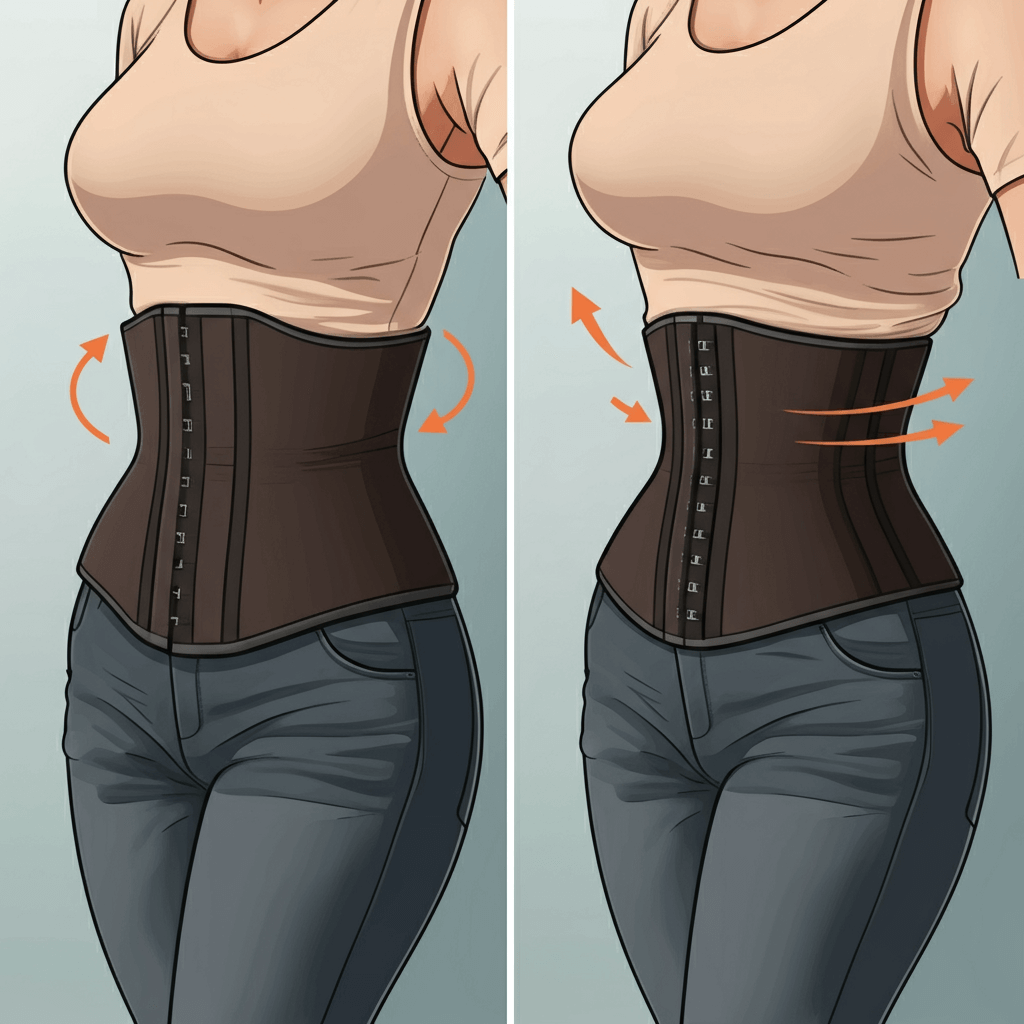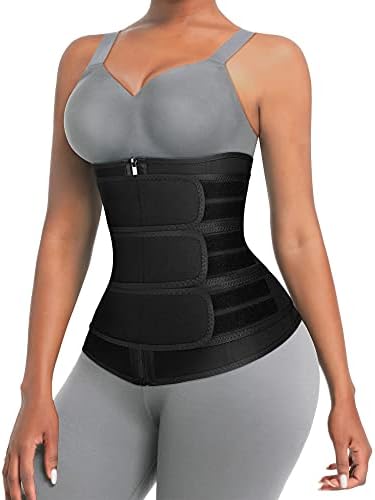
Waist trainers have exploded in popularity, with over 2.7 million Instagram posts showcasing seemingly overnight transformations into hourglass figures. The global waist trainer market reached $673 million in 2024, driven largely by celebrity endorsements and dramatic claims about permanent waistline reduction.
But behind the filtered photos and compelling testimonials lies a shocking reality gap between marketing promises and scientific evidence. This research-backed guide reveals what clinical studies actually demonstrate about waist trainers’ effectiveness, potential health impacts, and whether this $60-$200 investment can truly deliver the body transformation you’re seeking.
Table of Contents
What Exactly Are Waist Trainers?
Waist trainers are compression garments typically made from thick fabric and rigid boning, designed to be wrapped tightly around the midsection. They use laces, hooks, or Velcro to create significant pressure on the torso. Most manufacturers recommend wearing them for progressively longer periods—sometimes up to 8-10 hours daily—to “train” your waist into a smaller shape.
Modern waist trainers come in several varieties:
- Traditional corset-style trainers: Feature steel or plastic boning and lacing
- Latex waist cinchers: More flexible but still provide significant compression (often preferred for their exceptional durability)
- Workout waist trainers: Designed to be worn during exercise to increase sweat
- Postpartum bands: Marketed specifically to new mothers
- Vest-style trainers: Offering additional bust and back support
The materials vary widely, with high-quality options incorporating latex for compression, cotton linings for comfort in warm climates, and latex-free alternatives for those with sensitivities. The market has expanded significantly, valued at USD 100 Billion in 2023 and projected to reach USD 266 Billion by 2031, growing at an annual rate of 15%.

The Big Question: Do Waist Trainers Actually Work?
The honest answer is both yes and no—depending on what you’re expecting them to achieve.
Temporary Waist Reduction: Yes
Waist trainers undeniably create an immediate visual effect while wearing them. The compression physically pushes fat and skin inward while repositioning some internal organs temporarily. This instant hourglass shape disappears once the garment is removed.
Some users report continued slimming effects for a few hours after removal as the body readjusts. This temporary benefit makes waist trainers popular choices for special events or photographs.
Permanent Waist Reduction: No
Despite marketing claims, scientific evidence doesn’t support the idea that waist trainers can permanently reshape your body or redistribute fat. Dr. Caroline Apovian, professor of medicine at Boston University School of Medicine, explains: “Once you take the waist trainer off, your body will return to its usual shape. It’s not going to give you a permanent effect.”
The human body simply doesn’t work that way. Fat cells don’t permanently relocate due to external pressure, and adults’ skeletal structures are generally fixed.
Weight Loss: Minimal Evidence
Some waist trainer advocates claim the garments cause weight loss through increased sweating or by restricting food intake. While you might experience increased sweating while wearing one during exercise, this represents water loss, not fat reduction. The restricted eating some users report comes from uncomfortable pressure on the stomach, essentially creating a physical barrier to eating normally—not a healthy approach to portion control.
A robust 2023 study published in the Journal of Strength and Conditioning Research involving 137 participants found no evidence that waist trainers increased fat burning during exercise. In fact, metabolic measurements showed a 12% DECREASE in calorie expenditure due to restricted movement and breathing, completely contradicting marketing claims of enhanced fat loss.
Is Waist Training Right For You?
Social Media Reality Check
Despite the scientific evidence, waist trainers continue to grow in popularity, with over one million Instagram posts under “waist training” as of 2021. This disconnect between scientific reality and public perception is largely attributable to clever marketing, celebrity endorsements, and carefully curated before-and-after images that often manipulate lighting, posture, and timing to exaggerate results.

Potential Benefits of Waist Trainers
Despite the limitations, waist trainers may offer some legitimate benefits:
1. Improved Posture
The rigid structure forces your spine into alignment, serving as a physical reminder to sit and stand straighter. This temporary posture support might help people who struggle with slouching during wear. However, a 2022 study published in the Journal of Physical Therapy Science found that without concurrent core strengthening exercises, posture improvements disappeared within hours of removing the garment.
2. Postpartum Support
Some new mothers find specialized postpartum bands provide comfort as their bodies recover after childbirth. A 2019 review in the International Journal of Gynecology & Obstetrics showed these medical-grade devices can reduce discomfort and support abdominal muscles during early recovery. Important distinction: these specialized medical supports differ significantly from fashion waist trainers and should only be used under healthcare provider guidance.
3. Confidence Boost
The immediate visual transformation can provide a psychological boost for some users. This temporary confidence might motivate healthier behaviors, though the effect varies significantly between individuals.
4. Workout Intensity Cue
Some find the mild discomfort of waist trainers during workouts serves as a reminder to engage core muscles. However, this benefit can also be achieved through proper training techniques without potential drawbacks.
The Risks: What Doctors Warn About
Medical professionals consistently express concerns about potential health complications from regular waist trainer use:
1. Restricted Breathing
The compression severely limits diaphragm expansion. Research published in the Journal of Strength and Conditioning Research measured a 29-47% reduction in lung capacity in subjects wearing waist trainers during moderate exercise. This restriction causes measurable oxygen deprivation, leading to lightheadedness, shallow breathing, and up to 32% decreased exercise performance according to a 2023 study from the American College of Sports Medicine.
2. Digestive Issues
Compression can force the stomach and intestines into unnatural positions, potentially leading to acid reflux, indigestion, constipation, bloating, and gas. The pressure may also reduce normal gastrointestinal motility and function. This is particularly problematic for those who wear waist trainers during meals or for extended periods. Medical experts caution that the digestive discomfort experienced while wearing these garments is not merely an inconvenience but a warning sign of potential internal disruption.
3. Weakened Core Muscles
Relying on external support instead of activating natural core muscles leads to significant muscle atrophy. A 2021 longitudinal study published in the Journal of Biomechanics found participants who wore waist trainers 6+ hours daily for 8 weeks showed a 17% reduction in core muscle activation capacity and decreased muscle fiber recruitment during standard abdominal exercises. This muscle weakening ironically creates greater dependence on the waist trainer, forming a counterproductive cycle.
4. Skin Irritation and Nerve Damage
Prolonged pressure causes skin chafing, rashes, and bruising for many users. The synthetic, non-breathable materials commonly used in waist trainers trap heat and moisture against the skin, creating an ideal environment for irritation, particularly in those with sensitive skin or latex allergies. More concerning is potential nerve compression leading to numbness or tingling sensations, which can indicate nerve damage if the symptoms persist after removing the garment.
5. Organ Displacement
The extreme pressure forces internal organs from their optimal positions. Advanced imaging studies published in the Journal of Clinical Gastroenterology in 2022 documented stomach compression of up to 25% and kidney displacement of 1.7cm on average during waist trainer use. While these effects are temporary in occasional users, researchers found measurable changes in organ positioning persisted for 3-4 hours after removal. Historical medical records from Victorian-era corset wearers revealed permanent anatomical alterations with daily long-term use, including liver lobe elongation and intestinal repositioning.
Frequently Asked Questions About Waist Trainers
How Long Until I See Results From a Waist Trainer?
The visible “results” only last while wearing the device and perhaps for a short time afterward. Marketing claims about permanent results after weeks or months of use aren’t supported by scientific evidence.
Can Waist Trainers Help With Weight Loss?
Not significantly. While some users report eating less while wearing them due to stomach compression, and others note increased sweating during exercise, neither effect contributes meaningfully to fat reduction. Sustainable weight loss comes from caloric deficit through diet and exercise.
Are Waist Trainers Safe During Pregnancy?
Most medical professionals strongly advise against using waist trainers during pregnancy. The compression could restrict the growing baby’s space and potentially compromise blood flow to the placenta.
How Tight Should a Waist Trainer Be?
If you choose to use one, you should still be able to breathe fully and comfortably. If you experience numbness, tingling, pain, shortness of breath, or skin discoloration, the waist trainer is too tight and should be removed immediately.
How Many Hours Per Day Should You Wear a Waist Trainer?
Despite manufacturer recommendations of 8-10 hours daily, medical experts generally suggest limiting use to short periods, if at all. Extended wear increases the risks of complications without providing additional benefits.
Can You Sleep in a Waist Trainer?
Sleeping in a waist trainer is generally not recommended due to the increased risks of breathing difficulties, acid reflux, and physical discomfort that can disrupt sleep quality and potentially pose safety concerns.
Can Waist Trainers Help With Back Pain?
While they might offer temporary support, prolonged use can weaken core muscles, potentially exacerbating back pain in the long term. Some studies suggest corset-type garments may help certain individuals with chronic back pain, but it’s essential to consult with a healthcare professional for personalized advice rather than self-prescribing.
What Actually Works for Waist Reduction
For those seeking genuine, lasting changes to their waistline, evidence-backed approaches include:
1. Targeted Strength Training
Evidence-based core-strengthening protocols deliver genuine waist definition results. A 2023 study in the Journal of Sports Science documented a 2.1-inch average waist reduction after 12 weeks of specialized core training (including planks, Russian twists, and rotational exercises) combined with proper nutrition. Unlike waist trainers, this approach builds lasting functional strength while creating natural muscular definition that remains even at rest.
2. Consistent Cardiovascular Exercise
Regular cardio helps reduce overall body fat, including around the midsection. Whether walking, swimming, cycling, or dancing, finding sustainable activities you enjoy is key to consistency.
3. Balanced Nutrition
According to research published in the American Journal of Clinical Nutrition, nutrition accounts for approximately 70-80% of waist circumference changes. The most effective dietary approach combines moderate caloric deficit (15-20% below maintenance) with increased protein intake (1.6-1.8g per kg of body weight) and strategic fiber consumption (30-35g daily), which specifically targets visceral fat reduction. A 16-week controlled study showed this nutrition protocol alone reduced waist measurements by 3.4 inches on average—significantly outperforming all compression garment approaches.
4. Stress Management
The science is clear: chronic stress dramatically impacts waist measurements through cortisol-mediated abdominal fat storage. A landmark 2021 study in the Journal of Endocrinology found participants with elevated cortisol levels stored 3.7x more visceral fat than control groups. Just 8 weeks of consistent stress management (including 20 minutes of daily meditation, 7-8 hours of quality sleep, and weekly relaxation practices) reduced cortisol by 19% and decreased waist circumference by an average of 1.3 inches without any other interventions.
5. Patience and Consistency
Perhaps the most important factor—realistic expectations and consistent habits yield sustainable results, though typically over months rather than days or weeks.
The Bottom Line: Marketing vs. Reality
The dramatic before-and-after transformations in waist trainer advertisements typically combine several misleading elements:
- Photos taken while wearing the device versus without it
- Changing posture, lighting, and angles to accentuate differences
- Combining waist trainer use with unmentioned diet and exercise changes
- Selected testimonials that don’t represent average results
User experiences with waist trainers vary considerably. Some report feeling slimmer and experiencing improved posture while wearing them. However, others mention significant discomfort, movement limitations, and frustration with the temporary nature of results. Importantly, users who report positive long-term changes are often simultaneously adopting healthier diets and exercise routines, making it impossible to isolate the effect of the waist trainer itself.
While waist trainers can create temporary visual changes, they don’t deliver the long-term transformation many users hope for. Instead, they potentially introduce health risks that could ultimately interfere with achieving your body composition goals.
Conclusion
Waist trainers offer an appealing shortcut in a culture that values immediate results, but the science simply doesn’t support their effectiveness for lasting change. While they may have limited uses for temporary visual effects or specific supportive purposes, they cannot replace the fundamental habits that create true physical transformation.
If you choose to use a waist trainer for its temporary benefits, do so with realistic expectations and awareness of the potential risks. Consult healthcare providers, particularly if you have existing health conditions. Remember that sustainable body composition changes come from consistent healthy habits rather than compression garments, regardless of how convincingly they’re marketed.
For those seeking genuine transformation, invest your resources in quality nutrition, effective exercise, stress management, and adequate recovery—approaches with proven long-term benefits beyond mere appearance.






